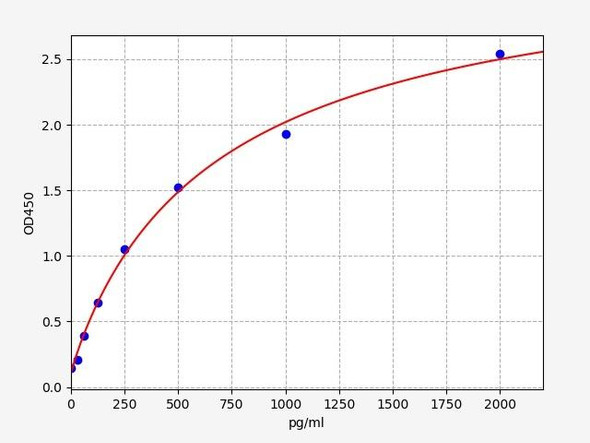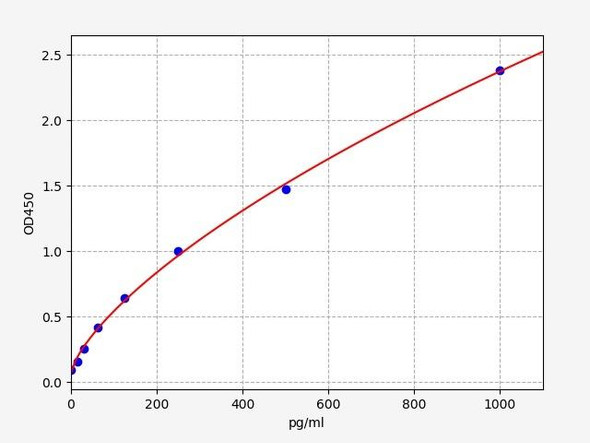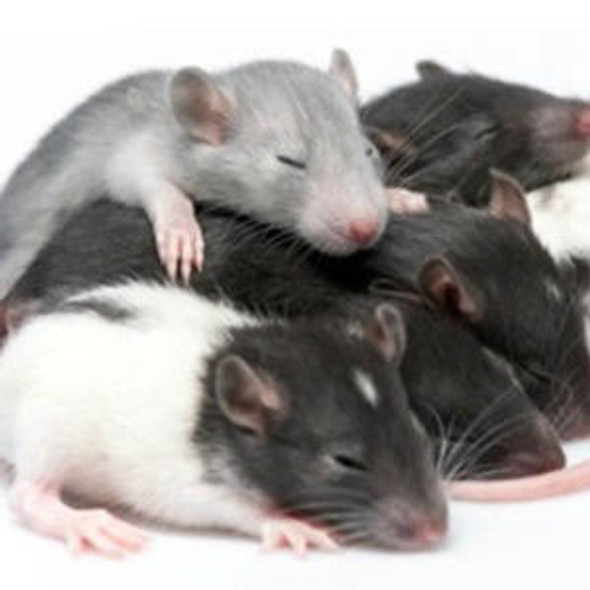Rat TGFB2 / TGF-beta 2 ELISA Kit
- SKU:
- RTFI00048
- Product Type:
- ELISA Kit
- Size:
- 96 Assays
- Uniprot:
- Q07257
- Sensitivity:
- 9.375pg/ml
- Range:
- 15.625-1000pg/ml
- ELISA Type:
- Sandwich ELISA, Double Antibody
- Synonyms:
- TGF-Beta2, Transforming Growth Factor Beta2, TGF-Beta2, TGFBeta2, TGFB2, BSC-1 cell growth inhibitor, Cetermin, G-TSF, Polyergin, polyergin, TGF-beta2, TGF-beta-2, transforming growth factor beta-2
- Reactivity:
- Rat
Description
| Product Name: | Rat TGF-beta2 (Transforming Growth Factor Beta 2) ELISA Kit |
| Product Code: | RTFI00048 |
| Size: | 96 Assays |
| Target: | Rat TGF-beta2 |
| Alias: | TGF-beta2, Transforming Growth Factor beta2, TGF-beta2, TGFbeta2, TGFB2, BSC-1 cell growth inhibitor, Cetermin, G-TSF, Polyergin, polyergin, TGF-beta2, TGF-beta-2, transforming growth factor beta-2 |
| Reactivity: | Rat |
| Detection Method: | Sandwich ELISA, Double Antibody |
| Sensitivity: | 9.375pg/ml |
| Range: | 15.625-1000pg/ml |
| Storage: | 4°C for 6 months |
| Note: | For Research Use Only |
| Recovery: | Matrices listed below were spiked with certain level of Rat TGF-beta2 and the recovery rates were calculated by comparing the measured value to the expected amount of Rat TGF-beta2 in samples. | ||||||||||||||||
| |||||||||||||||||
| Linearity: | The linearity of the kit was assayed by testing samples spiked with appropriate concentration of Rat TGF-beta2 and their serial dilutions. The results were demonstrated by the percentage of calculated concentration to the expected. | ||||||||||||||||
| |||||||||||||||||
| Intra-Assay: | CV <8% | ||||||||||||||||
| Inter-Assay: | CV <10% |
| Uniprot: | Q07257 |
| UniProt Protein Function: | TGFB2: TGF-beta 2 has suppressive effects on interleukin-2 dependent T-cell growth. Homodimer; disulfide-linked. Heterodimers with TGFB1 and with TGFB3 have been found in bone. Interacts with the serine proteases, HTRA1 and HTRA3. Interacts with ASPN. Belongs to the TGF-beta family. 2 isoforms of the human protein are produced by alternative splicing. |
| UniProt Protein Details: | Protein type:Cell development/differentiation; Motility/polarity/chemotaxis; Secreted; Secreted, signal peptide Cellular Component: axon; basement membrane; cell soma; cell surface; cytoplasm; endosome; extracellular matrix; extracellular region; extracellular space; secretory granule; trans-Golgi network Molecular Function:beta-amyloid binding; cytokine activity; protein heterodimerization activity; protein homodimerization activity; protein N-terminus binding; punt binding; receptor binding; receptor signaling protein serine/threonine kinase activity; transforming growth factor beta receptor binding Biological Process: activation of protein kinase activity; aging; axon guidance; blood vessel development; blood vessel remodeling; cardiac muscle cell proliferation; cardioblast differentiation; cartilage condensation; cell cycle arrest; cell death; cell development; cell migration; cell morphogenesis; collagen fibril organization; dopamine biosynthetic process; embryonic gut development; embryonic limb morphogenesis; embryonic neurocranium morphogenesis; epithelial to mesenchymal transition; extracellular matrix organization and biogenesis; eye development; female pregnancy; glial cell migration; gut development; hair follicle development; hair follicle morphogenesis; heart development; heart morphogenesis; hemopoiesis; hindbrain development; inner ear development; intercellular junction assembly and maintenance; kidney development; lung development; male gonad development; negative regulation of apoptosis; negative regulation of cell growth; negative regulation of cell proliferation; negative regulation of epithelial cell proliferation; negative regulation of immune response; negative regulation of Ras protein signal transduction; negative regulation of release of sequestered calcium ion into cytosol; neural tube closure; neuron development; neuron fate commitment; neutrophil chemotaxis; palate development; pancreas development; positive regulation of apoptosis; positive regulation of cardioblast differentiation; positive regulation of catagen; positive regulation of cell adhesion mediated by integrin; positive regulation of cell cycle; positive regulation of cell growth; positive regulation of cell migration; positive regulation of cell proliferation; positive regulation of heart contraction; positive regulation of immune response; positive regulation of integrin biosynthetic process; positive regulation of neuron apoptosis; positive regulation of ossification; positive regulation of phosphoinositide 3-kinase cascade; positive regulation of protein secretion; positive regulation of stress-activated MAPK cascade; protein amino acid phosphorylation; regulation of actin cytoskeleton organization and biogenesis; regulation of apoptosis; regulation of cell growth; regulation of cell proliferation; regulation of MAPKKK cascade; regulation of transforming growth factor-beta2 production; response to cold; response to cytokine stimulus; response to drug; response to estradiol stimulus; response to estrogen stimulus; response to hypoxia; response to organic nitrogen; response to progesterone stimulus; response to radiation; response to retinoic acid; response to vitamin D; response to wounding; salivary gland morphogenesis; skeletal development; skeletal muscle development; SMAD protein nuclear translocation; somatic stem cell division; thyroid gland development; transforming growth factor beta receptor signaling pathway; uterus development; wound healing |
| NCBI Summary: | binds the transforming growth factor-beta receptor; plays a role in regulation of cell growth and proliferation; may be involved in mesenchymal-epithelial cell interactions during development [RGD, Feb 2006] |
| UniProt Code: | Q07257 |
| NCBI GenInfo Identifier: | 20981713 |
| NCBI Gene ID: | 81809 |
| NCBI Accession: | Q07257.2 |
| UniProt Secondary Accession: | Q07257,Q63574, Q9QW26, Q9R281, Q9R298, Q9R2B8, Q9WUQ8 |
| UniProt Related Accession: | Q07257 |
| Molecular Weight: | 47,728 Da |
| NCBI Full Name: | Transforming growth factor beta-2 |
| NCBI Synonym Full Names: | transforming growth factor, beta 2 |
| NCBI Official Symbol: | Tgfb2 |
| NCBI Official Synonym Symbols: | TGF-B2 |
| NCBI Protein Information: | transforming growth factor beta-2; TGF-beta-2; TGF beta 2 protein |
| UniProt Protein Name: | Transforming growth factor beta-2 |
| Protein Family: | Transforming growth factor |
| UniProt Gene Name: | Tgfb2 |
| UniProt Entry Name: | TGFB2_RAT |
| Step | Procedure |
| 1. | Set standard, test sample and control (zero) wells on the pre-coated plate respectively, and then, record their positions. It is recommended to measure each standard and sample in duplicate. Wash plate 2 times before adding standard, sample and control (zero) wells! |
| 2. | Aliquot 0.1ml standard solutions into the standard wells. |
| 3. | Add 0.1 ml of Sample / Standard dilution buffer into the control (zero) well. |
| 4. | Add 0.1 ml of properly diluted sample ( Human serum, plasma, tissue homogenates and other biological fluids.) into test sample wells. |
| 5. | Seal the plate with a cover and incubate at 37°C for 90 min. |
| 6. | Remove the cover and discard the plate content, clap the plate on the absorbent filter papers or other absorbent material. Do NOT let the wells completely dry at any time. Wash plate X2. |
| 7. | Add 0.1 ml of Biotin- detection antibody working solution into the above wells (standard, test sample & zero wells). Add the solution at the bottom of each well without touching the side wall. |
| 8. | Seal the plate with a cover and incubate at 37°C for 60 min. |
| 9. | Remove the cover, and wash plate 3 times with Wash buffer. Let wash buffer rest in wells for 1 min between each wash. |
| 10. | Add 0.1 ml of SABC working solution into each well, cover the plate and incubate at 37°C for 30 min. |
| 11. | Remove the cover and wash plate 5 times with Wash buffer, and each time let the wash buffer stay in the wells for 1-2 min. |
| 12. | Add 90 µL of TMB substrate into each well, cover the plate and incubate at 37°C in dark within 10-20 min. (Note: This incubation time is for reference use only, the optimal time should be determined by end user.) And the shades of blue can be seen in the first 3-4 wells (with most concentrated standard solutions), the other wells show no obvious color. |
| 13. | Add 50 µL of Stop solution into each well and mix thoroughly. The color changes into yellow immediately. |
| 14. | Read the O.D. absorbance at 450 nm in a microplate reader immediately after adding the stop solution. |
When carrying out an ELISA assay it is important to prepare your samples in order to achieve the best possible results. Below we have a list of procedures for the preparation of samples for different sample types.
| Sample Type | Protocol |
| Serum: | If using serum separator tubes, allow samples to clot for 30 minutes at room temperature. Centrifuge for 10 minutes at 1,000x g. Collect the serum fraction and assay promptly or aliquot and store the samples at -80°C. Avoid multiple freeze-thaw cycles. If serum separator tubes are not being used, allow samples to clotovernight at 2-8°C. Centrifuge for 10 minutes at 1,000x g. Removeserum and assay promptly or aliquot and store the samples at-80°C. Avoid multiple freeze-thaw cycles. |
| Plasma: | Collect plasma using EDTA or heparin as an anti-coagulant. Centrifuge samples at 4°C for 15 mins at 1000 — g within 30 mins of collection. Collect the plasma fraction and assay promptly or aliquot and store the samples at -80°C. Avoid multiple freeze-thaw cycles.Note: Over haemolysed samples are not suitable for use with this kit. |
| Urine & Cerebrospinal Fluid: | Collect the urine (mid-stream) in a sterile container, centrifuge for 20 mins at 2000-3000 rpm. Remove supernatant and assay immediately. If any precipitation is detected, repeat the centrifugation step. A similar protocol can be used for cerebrospinal fluid. |
| Cell Culture Supernatant: | Collect the cell culture media by pipette, followed by centrifugation at 4°C for 20 mins at 1500 rpm. Collect the clear supernatant and assay immediately. |
| Cell Lysates: | Solubilize cells in lysis buffer and allow to sit on ice for 30 minutes. Centrifuge tubes at 14,000 x g for 5 minutes to remove insoluble material. Aliquot the supernatant into a new tube and discard the remaining whole cell extract. Quantify total protein concentration using a total protein assay. Assay immediately or aliquot and store at ≤ -20°C. |
| Tissue Homogenates: | The preparation of tissue homogenates will vary depending upon tissue type. Rinse tissue with 1X PBS to remove excess blood & homogenizein 20ml of 1X PBS (including protease inhibitors) and store overnight at ≤ -20°C. Two freeze-thaw cycles are required to break the cell membranes. To further disrupt the cell membranes you can sonicate the samples. Centrifuge homogenates for 5 mins at 5000xg. Remove the supernatant and assay immediately or aliquot and store at -20°C or-80°C. |
| Tissue Lysates: | Rinse tissue with PBS, cut into 1-2 mm pieces, and homogenize with a tissue homogenizer in PBS. Add an equal volume of RIPA buffer containing protease inhibitors and lyse tissues at room temperature for 30 minutes with gentle agitation. Centrifuge to remove debris. Quantify total protein concentration using a total protein assay. Assay immediately or aliquot and store at ≤ -20 °C. |
| Breast Milk: | Collect milk samples and centrifuge at 10,000 x g for 60 min at 4°C. Aliquot the supernatant and assay. For long term use, store samples at -80°C. Minimize freeze/thaw cycles. |










